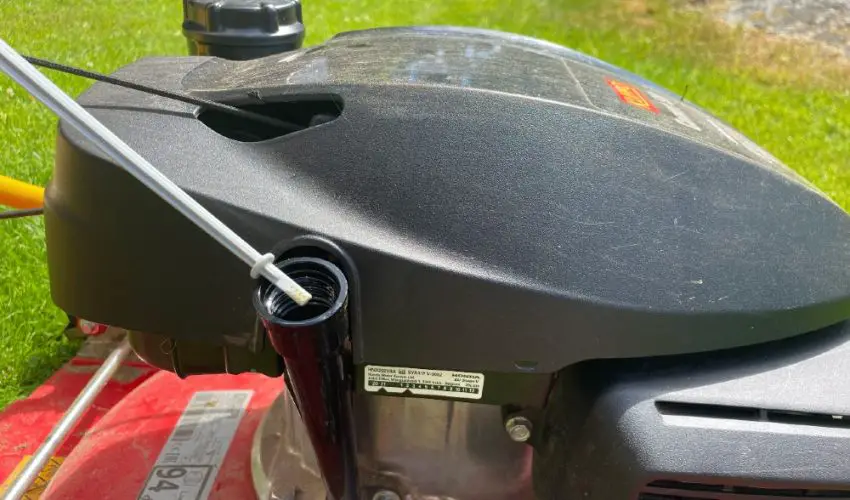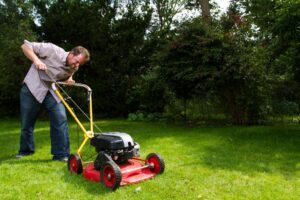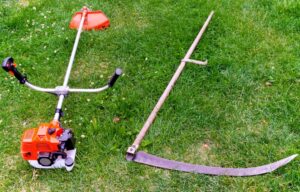When it comes to lawn mowers, two particularly well-known oil options are SAE 30 and 10W30. Both of these oils have their respective uses while also sharing more similarities than you may think. In this article, we’re going to go over both of these oil types to see which is best for you and your lawn mower.
Table of Contents
ToggleThe Difference Between SAE 30 & 10W30
The main difference between SAE 30 and 10W30 is that SAE 30 is a single-grade engine oil, while 10W30 is a multi-grade engine oil.
The grades of your oil affect its overall viscosity level as well as the ideal temperature. As an example, since SAE 30 is a single-grade oil, it needs to stay at a higher temperature level compared to 10W30, which, as multi-grade engine oil, has much more variety and wiggle room when it comes to temperature.
| Feature | SAE 30 | 10W-30 |
|---|---|---|
| Viscosity at room temperature | 30 | 10 |
| Viscosity at high temperatures | 30 | 30 |
| Suitability for cold temperatures | Poor | Good |
| Suitability for high temperatures | Good | Good |
| Flowability in cold temperatures | Poor | Good |
| Flowability in high temperatures | Good | Good |
| Energy efficiency | Good | Good |
| Protection against wear and tear | Good | Good |
| Compatibility with fuel economy | Poor | Good |
| Compatibility with diesel engines | Poor | Good |
When To Use SAE 30
SAE 30, as mentioned earlier, is going to have a smaller range of uses compared to 10W30. This is because, as single-grade engine oil, its viscosity levels will only stay at a 30-rating while at a temperature of 212 degrees Fahrenheit (100 degrees Celsius).
That isn’t to say that there aren’t important uses for SAE 30. Most tractors, chainsaws, lawn mowers, and other smaller air-cooled engines will use a single-grade engine oil like SAE 30. This is because they tend to run at high temperatures regularly with hot engines going throughout their use.
As such, SAE 30, which is only useful at these high-heat levels, can run effectively without too much causing you a problem.
When To Use 10W30
Where SAE 30 is useful for its use in high-heat situations, the challenge comes when exposed to cooler engines or overall temperatures. 10W30, on the other hand, is a multi-grade engine oil – in this case, a double-grade – that can function well in both hotter and cooler temperatures. The “W” in 10W30 stands for “winter”.
Because of its multiple temperatures, not only can it work for the same machines as the SAE 30, reaching the same oil viscosity when run hot, but it can also be used in cooler climates and temperatures which may naturally create colder engines due to the weather. Multi-grade oils are essential if you are in colder areas, as this can prevent locking or jam on an otherwise functional engine.
What Does SAE 30 Mean?
The term SAE 30 is short for “Society of Automotive Engineers”. They are the group that standardizes all viscosity ratings for engine oils. As such, the SAE 30 oil has a viscosity rating of “30” on a scale of 0-100.
What Does 10W30 Mean?
While SAE 30’s name includes the name of the oil viscosity rating group, the same isn’t the case for 10W30. However, you may have begun to pick up that the “10” and the “30” mean something, particularly something to do with the viscosity rating.
In the case of 10W30, the “30” is its standard rating when run at 212 degrees. The “10”, however, is used to describe the viscosity rating when in climates under that 212-degree setting. The “W” actually stands for “winter”. This means that 10W30 means a 10-rating in the winter and a 30-rating standard.
Is SAE 30 The Same As 10W30?
So, if SAE 30 and 10W30 both have a standard 30-rating when run hot, that would logically make them the same engine oil, right?
Well, yes… but also no. You see, it’s important to remember that SAE 30 is a single-grade engine oil while 10W30 is a multi-grade engine oil (also known as “blended” engine oil). It’s more accurate to say that 10W30 has elements of SAE 30 while not being the same. This is especially the case when dealing with cooler engines or weather, where SAE 30 will be all but worthless while 10W30 shouldn’t have any issues.
Can I Use 10W30 Instead Of SAE 30 In My Lawn mower?
10W30 can replace SAE 30 in most cases when it comes to newer lawn mowers and tractors, but there are still some older lawn mower models are only meant to run on single-grade oil and may not run as effectively when exposed to multi-grade oil.
Because of this, while you shouldn’t have an issue in most cases, you always want to go over the specifics of your lawn mower in your owner’s manual. If it calls for only SAE 30 as the ideal or recommended oil of choice, you’re better off just using SAE 30 for optimal performance.
Can I Mix SAE 30 With 10W30?
It’s not recommended to mix SAE30 and 10W10. Yes, SAE 30 and 10W30 do share some similarities, however, they are also two entirely different grades of engine oil. Not only that but one can argue that 10W30 is already mixed with SAE 30.
Regardless, when processed, blended engine oils are done so at precise levels that are more than just pouring two different oils into one bottle at the same time. Ultimately, while it’s unwise to mix any engine oil, you want to avoid mixing two engine oils that have entirely different grades.
How Long Does SAE 30 Oil Last?
A bottle of SAE30 will last between 2 – 5 years, Depending on the brand you’re using. You’ll also want to factor in if it’s been opened or tampered with at all. These all are factors to consider, though most unopened bottles of SAE 30 aren’t going to expire any time soon.
Conclusion
SAE30 is usually used in older lawn mowers and warmer environments, while 10W30 is best suited for newer lawn mowers and colder environments.




